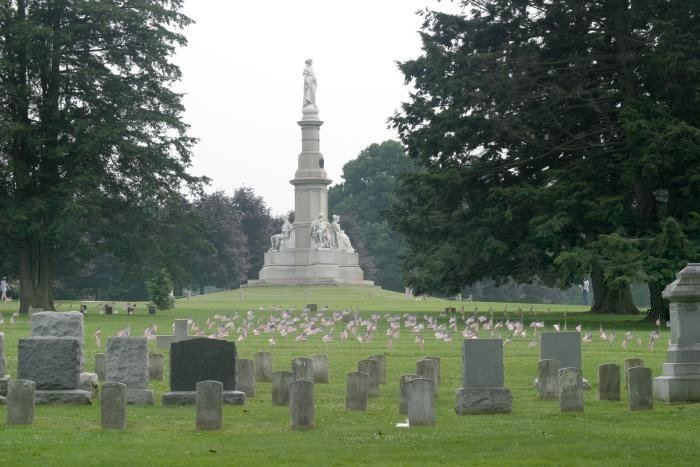Phone +1 717-334-1124 | ||
 | ||
Hours Open today · 6AM–7PMMonday6AM–7PMTuesday6AM–7PMWednesday6AM–7PMThursday6AM–7PMFriday6AM–7PMSaturday6AM–7PMSunday6AM–7PM Burials Amos Humiston, Charles H. T. Collis, Arthur S. Nevins Similar Gettysburg Battlefield, Gettysburg National Military P, Eisenhower National Historic S, Jennie Wade House, Sachs Covered Bridge | ||
Gettysburg national cemetery a final resting place
Gettysburg National Cemetery is a United States national cemetery created for Union casualties of the July 1 to 3, 1863 Battle of Gettysburg in the American Civil War. It is located just outside Gettysburg Borough, in Adams County, Pennsylvania. The land was part of the Gettysburg Battlefield, and the cemetery is within Gettysburg National Military Park.
Contents
- Gettysburg national cemetery a final resting place
- Gettysburg national cemetery
- Description
- Reinterments
- References
Originally called Soldiers' National Cemetery, U.S. President Abraham Lincoln delivered his Gettysburg Address at the cemetery's consecration, November 19, 1863.
The cemetery contains 3,512 interments from the Civil War, including the graves of 979 unknowns. It also has sections for veterans of the Spanish–American War, World War I, and other wars, along with graves of the veterans' spouses and children. The total number of interments exceeds 6,000.
Battlefield monuments, memorials, and markers are scattered throughout the cemetery, and its stone walls, iron fences and gates, burial and section markers, and brick sidewalk are listed as contributing structures within Gettysburg Battlefield Historic District.
Gettysburg national cemetery
Description
The centerpiece of Gettysburg National Cemetery is Soldiers' National Monument (1869), a 60-foot-tall (18 m) granite monument designed by sculptor Randolph Rogers and architect George Keller. It is surrounded by concentric semicircles of graves, divided into 18 sections for Union states (1 each), a section for United States Regulars, and 3 sections for unknown soldiers.
Battlefield monuments within Gettysburg National Cemetery include those of the 1st United States Artillery Battery H, the 2nd Maine Battery, the 1st Massachusetts Battery (Cook's Battery), the 1st Minnesota Infantry, the 1st New Hampshire Light Battery, the 5th New York Independent Light Artillery, the 136th New York Volunteer Infantry, the 1st Ohio Battery H, the 55th Ohio Infantry, the 73rd Ohio Infantry, and the 75th Pennsylvania Infantry; and markers for the 1st Ohio Battery I and the 3rd Volunteer Brigade Artillery Reserve (Huntington's Brigade). Other monuments include the New York State Monument (1893), the Kentucky State Monument (1975), the Lincoln Address Monument (1912), the Friend to Friend Masonic Memorial (1994), the Major-General John F. Reynolds Statue (1872), and the Major-General Charles Collis Memorial (1906).
Reinterments
Union remains were transferred from the Gettysburg Battlefield burial plots (e.g., on Cemetery Hill) as well as local church cemeteries, field hospital burial sites (e.g., Camp Letterman & the Rock Creek-White Run Union Hospital Complex), the "USA General Hospital, York, Pa." and the Valley of Death where unburied soldiers decomposed in place. Samuel Weaver, as "Superintendent of the exhuming of the bodies", personally observed the contractor's workers opening graves, placing remains in coffins, and burying them in the cemetery, and at least 1 reinterment was from the neighboring Evergreen Cemetery (Adams County, Pennsylvania).
